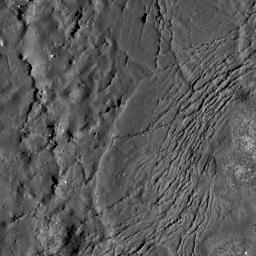
|
Necho Crater
- Click the image above for a larger view
- Full-Res JPEG (1000 x 1000) (152.0 kB)
- Full-Res TIFF (1000 x 1000) (1.0 MB)
Caption:
Cracks form in the impact melt sheet on the floor of Necho Crater. Image width is 1.04 km.
Necho is a Copernican-aged, 30-km diameter crater on the far side of the Moon (5° S, 123° E). Named after an Egyptian pharaoh, this crater formed in the lunar highlands and has a complex structure and morphology. The bright rays of the crater and lack of superimposed impacts is evidence that Necho is a young, fresh crater. Similar to other young impact craters the floor is flooded with massive amounts impact melt. Impact melt is instant lava, lunar rock melted in an instant as the tremendous energy of impact is released.The melt pools in the bottom of the crater,perches on terraces and flows down the flanks. Often times distinct flows can be found that look just like lava flows found on Earth. This portion of the NAC frame (above) shows cracks, 10 to 15 m wide, within the impact melt on the crater floor which formed as the melt cooled and the crater floor was readjusting.
Background Info:
NASA's Goddard Space Flight Center built and manages the mission for the Exploration Systems Mission Directorate at NASA Headquarters in Washington. The Lunar Reconnaissance Orbiter Camera was designed to acquire data for landing site certification and to conduct polar illumination studies and global mapping. Operated by Arizona State University, the LROC facility is part of the School of Earth and Space Exploration (SESE). LROC consists of a pair of narrow-angle cameras (NAC) and a single wide-angle camera (WAC). The mission is expected to return over 70 terabytes of image data.
Cataloging Keywords:
| Name | Value | Additional Values |
|---|---|---|
| Target | Moon | |
| System | Earth | |
| Target Type | Satellite | |
| Mission | Lunar Reconnaissance Orbiter (LRO) | |
| Instrument Host | Lunar Reconnaissance Orbiter | |
| Host Type | Orbiter | |
| Instrument | Lunar Reconnaissance Orbiter Camera (NAC) | |
| Detector | Narrow Angle Camera (NAC), Wide Angle Camera (WAC) | |
| Extra Keywords | Crater, Grayscale, Impact | |
| Acquisition Date | ||
| Release Date | 2009-08-21 | |
| Date in Caption | ||
| Image Credit | NASA/GSFC/Arizona State University | |
| Source | photojournal.jpl.nasa.gov/catalog/PIA12898 | |
| Identifier | PIA12898 | |
